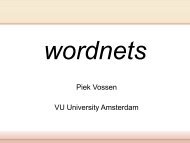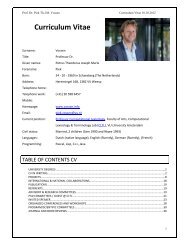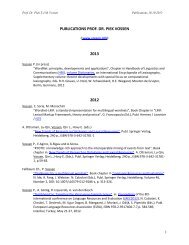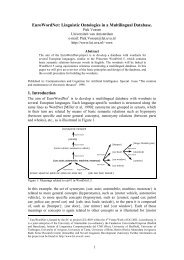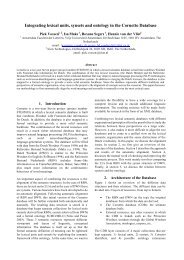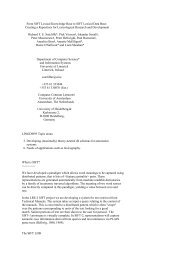KAF: a generic semantic annotation format
KAF: a generic semantic annotation format
KAF: a generic semantic annotation format
Create successful ePaper yourself
Turn your PDF publications into a flip-book with our unique Google optimized e-Paper software.
<strong>KAF</strong>: a <strong>generic</strong> <strong>semantic</strong><br />
<strong>annotation</strong> <strong>format</strong><br />
Wauter Bosma & Piek Vossen (VU University Amsterdam)<br />
Aitor Soroa & German Rigau (Basque Country University)<br />
Maurizio Tesconi & Andrea Marchetti (CNR-IIT, Pisa)<br />
Carlo Aliprandi (Synthema, Pisa)<br />
Monica Monachini (CNR-ILC, Pisa)<br />
KYOTO<br />
EU-FP7 ICT Program
KYOTO – overview<br />
<br />
<br />
<br />
<br />
<br />
A system for defining and sharing meaning in a<br />
domain<br />
<br />
<br />
<br />
Domain wordnet (linked to <strong>generic</strong> wordnet)<br />
Ontology (linked to wordnet)<br />
Fact profiles<br />
Semantic interoperability<br />
Knowledge is maintained by end-users<br />
System can be used for extracting factual data<br />
from documents<br />
Cross-language; cross-culture
KYOTO – some statistics<br />
<br />
March 2008 – March 2011<br />
<br />
<br />
<br />
8 countries (The Netherlands, Italy, Germany,<br />
Spain, Taiwan, Japan, Czech Republic)<br />
12 sites<br />
<br />
<br />
<br />
Universities & research institutes: VUA, CNR-ILC,<br />
CNR-IIT, BBAW, EHU, AS, NICT, Masaryk<br />
Companies: Synthema, Irion<br />
User organizations: ECNC, WWF<br />
7 languages (English, Italian, Japanese, Dutch,<br />
Spanish, Basque, Chinese)
KYOTO – knowledge cycle
Linguistic<br />
Processor<br />
Wordnets & Ontology<br />
Multilingual<br />
Knowledge Base<br />
Kybot<br />
Fact Extractor<br />
Fact Base<br />
2<br />
Semantic & Syntactic<br />
representation<br />
Kyoto Annotation Format<br />
Tybot<br />
Term Extractor<br />
1<br />
Wikyoto<br />
Wiki Editor<br />
Term Base
Requirements for <strong>semantic</strong><br />
<strong>annotation</strong> in KYOTO<br />
<br />
<br />
<br />
Interoperability across languages and cultures<br />
<br />
<br />
Language-neutral <strong>annotation</strong><br />
One <strong>format</strong> for all languages<br />
Interoperability across linguistic processors<br />
<br />
<br />
Specialized processors for specific tasks<br />
System should work with new (unknown) languages<br />
Flexibility and extendibility, as requirements<br />
for applications may change over time
The KYOTO way<br />
<br />
<br />
<br />
<br />
<br />
<strong>KAF</strong>: KYOTO/Knowledge Annotation Format<br />
Annotation consists of layers stacked on top of each other<br />
Layers are used to generate more<br />
sophisticated layers<br />
<br />
Morpho-syntactic layers –<br />
language specific parsing<br />
<br />
<br />
Level-1 <strong>semantic</strong> layers – named<br />
entities, events, etc.<br />
Level-2 <strong>semantic</strong> layers – facts<br />
Layers refer to items in lower level layers<br />
<strong>KAF</strong> is LAF-compliant<br />
Level-2 <strong>semantic</strong> layers<br />
Level-1 <strong>semantic</strong> layers<br />
Morpho-syntactic layers
Morpho-syntactic layers<br />
<br />
<br />
<br />
<br />
Text: tokenization, sentences,<br />
paragraphs, with reference to the<br />
source<br />
Terms [Text]: words and multiwords,<br />
includes parts-of-speech,<br />
declension in<strong>format</strong>ion, etc.<br />
Dependencies [Terms]:<br />
dependency relations between<br />
terms<br />
Chunks [Terms]: constituents &<br />
phrases<br />
Level-2 <strong>semantic</strong> layers<br />
Level-1 <strong>semantic</strong> layers<br />
Chunks<br />
Dependencies<br />
Terms<br />
Text
Semantic layers<br />
<br />
<br />
<br />
Level-1 layers for linear <strong>annotation</strong>: tagging<br />
text elements (expressions of time, events,<br />
quantities, locations, etc.)<br />
Level-2 layers for <strong>generic</strong> <strong>annotation</strong>:<br />
extracted facts (with pointers to evidence in the<br />
text) – possibly multiple sources of evidence<br />
Linear vs. Generic ↔ In<strong>format</strong>ion vs.<br />
Knowledge
General <strong>KAF</strong> layout<br />
<br />
...<br />
layer 1...<br />
layer 2...<br />
...<br />
layer N...<br />
Morpho-syntactic <strong>annotation</strong>:<br />
text and terms<br />
<br />
<br />
tw o <br />
pe r<br />
c e nt<br />
<br />
<br />
<br />
<br />
<br />
<br />
<br />
Morpho-syntactic <strong>annotation</strong>:<br />
deps and chunks<br />
<br />
...<br />
...<br />
<br />
<br />
<br />
<br />
<br />
<br />
<br />
<br />
<br />
<br />
Linear <strong>semantic</strong> <strong>annotation</strong><br />
<br />
<br />
<br />
<br />
<br />
<br />
<br />
<br />
<br />
<br />
Generic <strong>annotation</strong><br />
<br />
<br />
<br />
<br />
<br />
<br />
<br />
<br />
<br />
<br />
<br />
<br />
Generic <strong>annotation</strong><br />
<br />
<br />
<br />
<br />
<br />
<br />
<br />
<br />
<br />
<br />
<br />
<br />
<br />
<br />
facts<br />
entities<br />
<strong>semantic</strong> roles<br />
dependencies<br />
chunks<br />
term: migration<br />
Wordnet synset {eng-30-6766767-v}<br />
Ontology Type = MigrationProcess<br />
- MigratingSpecies<br />
- Source<br />
- Path<br />
- Distance<br />
word: migration
<strong>KAF</strong> in KYOTO<br />
<br />
<br />
<br />
<br />
<br />
Word Sense Disambiguation adds sense <strong>annotation</strong> to the<br />
terms layer of <strong>KAF</strong><br />
Tybots (term yielding robots) use <strong>KAF</strong> for term extraction<br />
<br />
Uses the terms layer and the chunks layer<br />
Kybots (knowledge yielding robots) use <strong>KAF</strong> for fact<br />
extraction<br />
<br />
Kybot is configured to search for specific facts by<br />
defining a kybot profile<br />
Wikyoto allows domain experts to define kybot profiles<br />
and to build a domain wordnet from Tybot terms, linked<br />
to a shared ontology<br />
All of the above are language-neutral
<strong>KAF</strong> and ISO standards<br />
<br />
<br />
<br />
<br />
<strong>KAF</strong> is inspired by: SynAF (dependency<br />
relations), MAF (morphological <strong>annotation</strong>),<br />
SemAF (time and events), LAF (<strong>generic</strong><br />
linguistic <strong>annotation</strong> framework)<br />
SynAF, MAF and SemAF cannot be stacked<br />
LAF is a data model rather than a standard<br />
<strong>KAF</strong> is an instantiation of LAF with elements<br />
from SynAF, MAF and SemAF
Conclusion<br />
<br />
<br />
<br />
Key features of <strong>KAF</strong>:<br />
<br />
<br />
<br />
<br />
Layered <strong>annotation</strong>; extendible for new applications<br />
Distributed processing<br />
Language neutral processing<br />
Sharing & reusing resources<br />
<strong>KAF</strong> in KYOTO:<br />
<br />
<br />
Three types of <strong>annotation</strong>: morphosyntactic, linear<br />
(level-1 <strong>semantic</strong>) and <strong>generic</strong> (level-2 <strong>semantic</strong>)<br />
Used for 7 languages in several applications<br />
<strong>KAF</strong> manual: www.kyoto-project.eu (under system<br />
architecture and demos, data <strong>format</strong>s)





